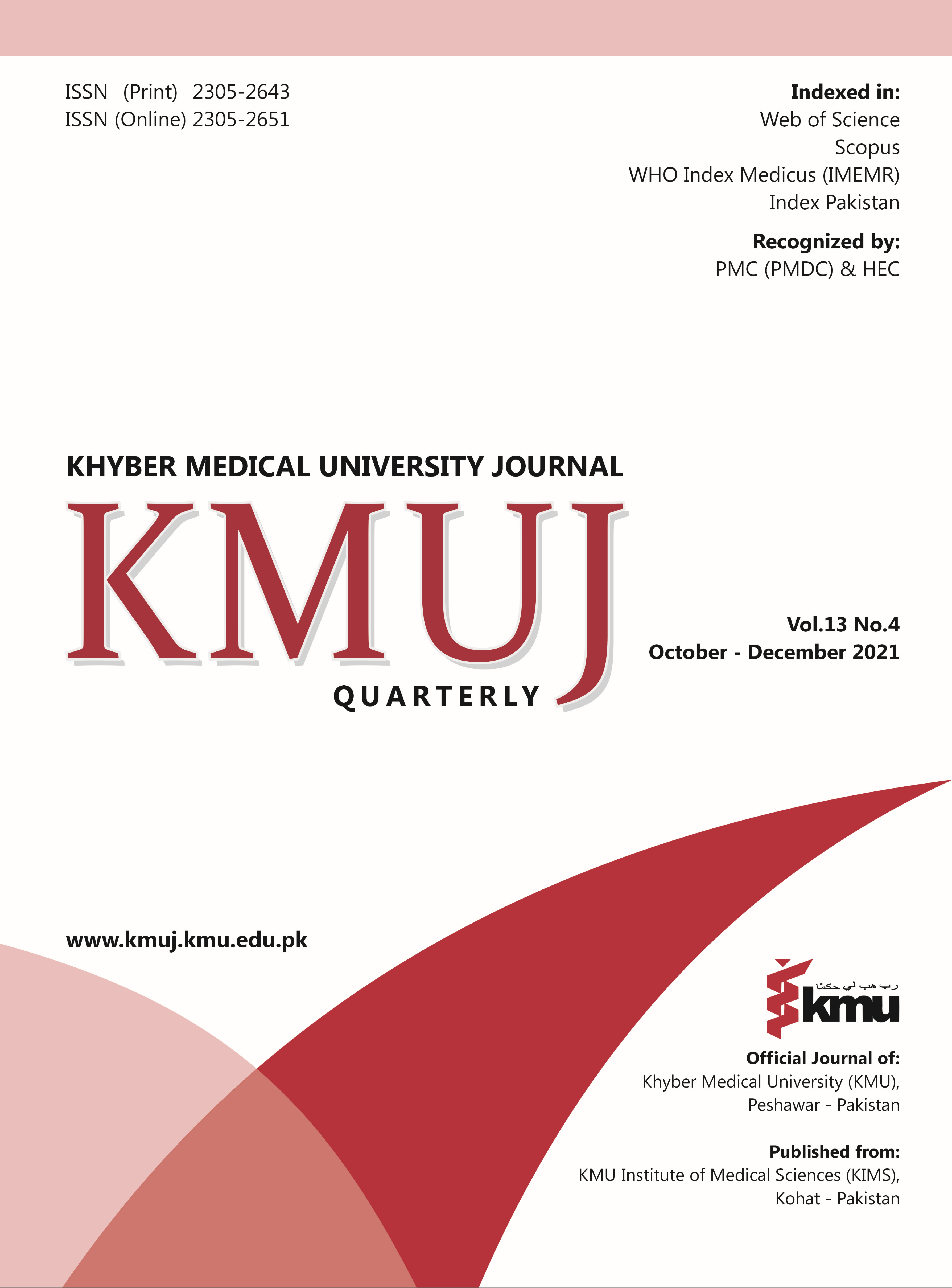RISK FACTORS ASSOCIATED WITH UPPER CROSSED SYNDROME IN FEMALES OF AGE 25-50 YEARS: A POPULATION-BASED CASE CONTROL STUDY
Main Article Content
Abstract
OBJECTIVE: To assess the risk factors associated with upper crossed syndrome (UCS) in females of age 25-50 years.
METHODS: This population based case controlled study was conducted from May to August 2019. Total of 210 females including 105 cases (participants who had upper neck pain for at least one month) and 105 controls (participants who didn't had upper neck pain), aging 25-50 years were selected through non-probability convenient sampling technique from the population of Gujrat, Punjab Pakistan. Data was collected through a pre-tested questionnaire and analyzed through SPSS software (version 21.0). Universal goniometer used to assess cervical ranges. Neck disability index (NDI) was used for functional disability and visual analog scale (VAS) was applied to assess the degree of pain.
RESULTS: Majority (n=88; 41.90%) of females were in age group of 25-30 years and were housewives (n=147; 70 %). Females who used handheld devices, unsupported back chairs, read, worked, travelled for more than 3 hours had 63.91, 9.127, 3.568, 3.301, 2.068 folds risk of developing UCS respectively as compared to those who did the same for less than 3 hours. Similarly, females who were fetal sleeper had 2.032 times more risk of than front sleeper. All risk factors were statistically significant (p< 0.005).
CONCLUSION: Usage of handheld devices while reading, working, and travelling for >3 hours, sleeping with curved spine and in fetal position and unsupported back chair increase the risk of UCS.
Article Details
Work published in KMUJ is licensed under a
Creative Commons Attribution 4.0 License
Authors are permitted and encouraged to post their work online (e.g., in institutional repositories or on their website) prior to and during the submission process, as it can lead to productive exchanges, as well as earlier and greater citation of published work.
(e.g., in institutional repositories or on their website) prior to and during the submission process, as it can lead to productive exchanges, as well as earlier and greater citation of published work.
References
Daneshmandi H, Harati J, Poor SF. Bodybuilding links to upper crossed syndrome. Physic Act Rev 2017;5:124-31. https://doi.org/10.16926/par.2017.05.17
Moore MK. Upper crossed syndrome and its relationship to cervicogenic headache. J Manipulative Physiol Ther 2004;27(6):414-20. https://doi.org/10.1016/j.jmpt.2004.05.007.
Chiu TTW, Ku WY, Lee MH, Sum WK, Wan MP, Wong CY, et al. A study on the prevalence of and risk factors for neck pain among university academic staff in Hong Kong. J Occup Rehabil 2002;12(2):77-91. https://doi.org/10.1023/a:1015008513575.
Yip CHT, Chiu TTW, Poon ATK. The relationship between head posture and severity and disability of patients with neck pain. Man Ther 2008;13(2):148-54. https://doi.org/10.1016/j.math.2006.11.002.
van der Windt DA, Thomas E, Pope DP, de Winter AF, Macfarlane GJ, Bouter LM, et al. Occupational risk factors for shoulder pain: a systematic review. Occup Environ Med 2000;57(7):433-42. https://doi.org/10.1136/oem.57.7.433.
Lafond D, Descarreaux M, Normand MC, Harrison DE. Postural development in school children: a cross-sectional study. Chiropr Osteopat 2007;15(1):1. https://doi.org/10.1186/1746-1340-15-1.
Klussmann A, Gebhardt H, Liebers F, Rieger MA. Musculoskeletal symptoms of the upper extremities and the neck: a cross-sectional study on prevalence and symptom-predicting factors at visual display terminal (VDT) workstations. BMC Musculoskelet Disord 2008;9:96. https://doi.org/10.1186/1471-2474-9-96.
Salahzadeh Z, Maroufi N, Ahmadi A, Behtash H, Razmjoo A, Gohari M, et al. Assessment of forward head posture in females: observational and photogrammetry methods. J Back Musculoskelet Rehabil 2014;27(2):131-9. https://doi.org/10.3233/BMR-130426
Charan J, Biswas T. How to calculate sample size for different study designs in medical research? Indian J Psychol Med 2013;35(2):121. https://doi.org/10.4103/0253-7176.116232.
De-La-Llave-Rincón AI, Fernández-De-Las-PeÑas C, Palacios-CeÑa D, Cleland JA. Increased forward head posture and restricted cervical range of motion in patients with carpal tunnel syndrome. J Orthop Sports Phys Ther 2009;39(9):658-64. https://doi.org/10.2519/jospt.2009.3058.
Ma M, Zhang SM, Zhang YD, Li ZX, Wu GN, Zhang XJ, et al. Preliminary analysis on X-ray in youth neck type of cervical spondylosis with upper crossed syndrome. Zhongguo Gu Shang 2019;32(3):225-9. https://doi.org/10.3969/j.issn.1003-0034.2019.03.006.
Ayaz SB, Malik R, Khan AA, Gill ZA, Akhtar N, Matee S. Intensity of neck pain secondary to excessive flexion posturing, its association with study activities and duration of posturing and impact on sleep in students of Women Medical College, Abbottabad. Pak Armed Forces Med J 2016;66(0):S22-5.
Kim EK, Kim JS. Correlation between rounded shoulder posture, neck disability indices, and degree of forward head posture. J Phys Ther Sci 2016;28(10):2929-32. https://doi.org/10.1589/jpts.28.2929.
Ming Z, Närhi M, Siivola J. Neck and shoulder pain related to computer use. Pathophysiology 2004;11(1):51-6. https://doi.org/10.1016/j.pathophys.2004.03.001.
Nejati P, Lotfian S, Moezy A, Nejati M. The study of correlation between forward head posture and neck pain in Iranian office workers. Int J Occup Med Environ Health 2015;28(2). https://doi.org/10.13075/ijomeh.1896.00352.
